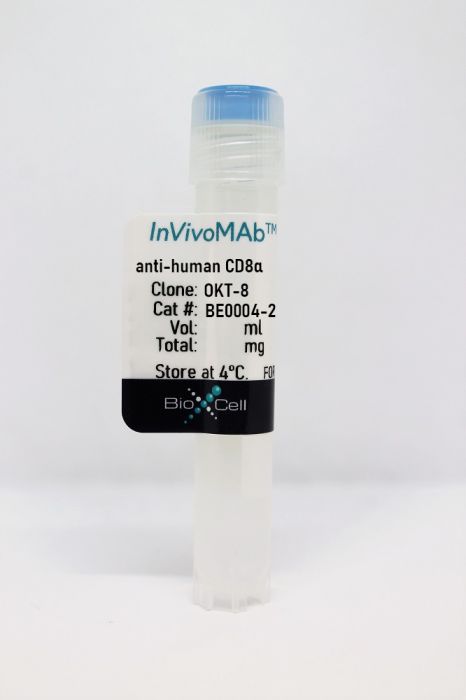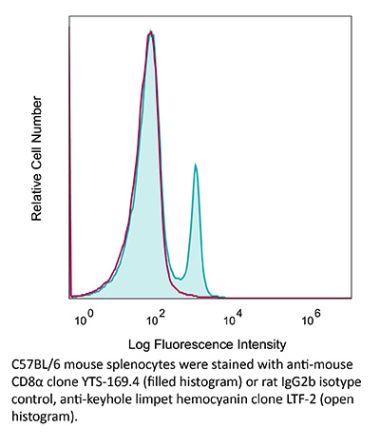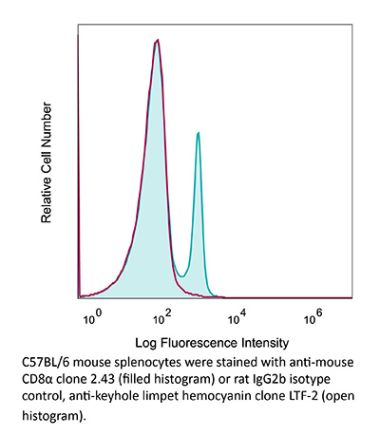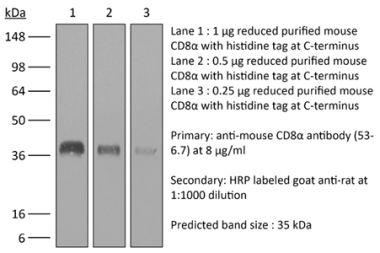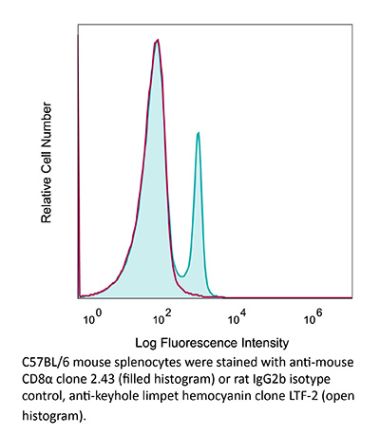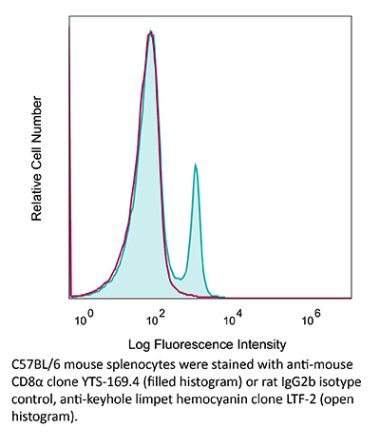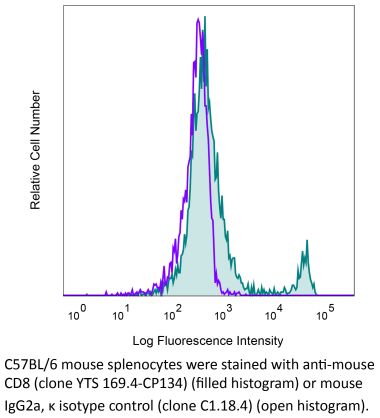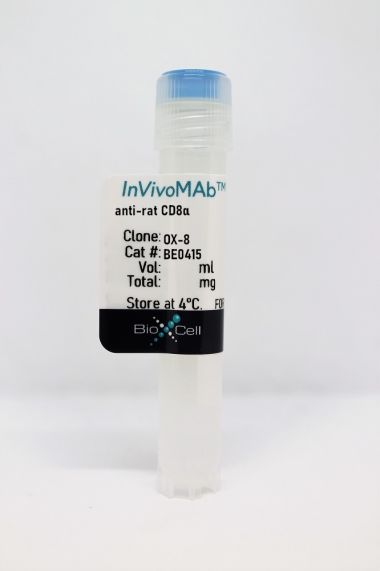InVivoMAb anti-human CD8α
Product Details
The OKT-8 monoclonal antibody reacts with human CD8α. The CD8 antigen is a transmembrane glycoprotein that acts as a co-receptor for the T cell receptor (TCR). Like the TCR, CD8 binds to class I MHC molecules displayed by antigen presenting cells (APC). CD8 is primarily expressed on the surface of cytotoxic T cells, but can also be found on thymocytes, natural killer cells, and some dendritic cell subsets. CD8 most commonly exists as a heterodimer composed of one CD8α and one CD8β chain however, it can also exist as a homodimer composed of two CD8α chains. Both the CD8α and CD8β chains share significant homology to immunoglobulin variable light chains. The molecular weight of each CD8 chain is approximately 34 kDa. The OKT-8 antibody does not block the binding of the anti-human CD8α antibodies RPA-T8 and HIT8a.Specifications
| Isotype | Mouse IgG2a |
|---|---|
| Recommended Isotype Control(s) | InVivoMAb mouse IgG2a isotype control, unknown specificity |
| Recommended Dilution Buffer | InVivoPure pH 6.0T Dilution Buffer |
| Conjugation | This product is unconjugated. Conjugation is available via our Antibody Conjugation Services. |
| Immunogen | Human CD8α |
| Reported Applications | in vivo CD8+ T cell depletion in humanized mice |
| Formulation |
PBS, pH 6.0 0.01% Tween Contains no stabilizers or preservatives |
| Endotoxin |
<2EU/mg (<0.002EU/μg) Determined by LAL gel clotting assay |
| Purity |
>95% Determined by SDS-PAGE |
| Sterility | 0.2 µm filtration |
| Production | Purified from cell culture supernatant in an animal-free facility |
| Purification | Protein G |
| RRID | AB_1107673 |
| Molecular Weight | 150 kDa |
| Storage | The antibody solution should be stored at the stock concentration at 4°C. Do not freeze. |
Recommended Products
in vivo CD8+ T cell depletion in humanized mice
Chijioke, O., et al. (2015). "Role of the 2B4 Receptor in CD8+ T-Cell-Dependent Immune Control of Epstein-Barr Virus Infection in Mice With Reconstituted Human Immune System Components" J Infect Dis 212(5): 803-807. PubMed
Patients with X-linked lymphoproliferative (XLP) disease due to deficiency in the adaptor molecule signaling lymphocytic activation molecule-associated protein (SAP) are highly susceptible to one specific viral pathogen, the Epstein-Barr virus (EBV). This susceptibility might result from impaired CD8(+) T-cell and natural killer cell responses to EBV infection in these patients. We demonstrate that antibody blocking of the SAP-dependent 2B4 receptor is sufficient to induce XLP-like aggravation of EBV disease in mice with reconstituted human immune system components. CD8(+) T cells require 2B4 for EBV-specific immune control, because 2B4 blockade after CD8(+) T-cell depletion did not further aggravate symptoms of EBV infection.
in vivo CD8+ T cell depletion in humanized mice
Billerbeck, E., et al. (2013). "Characterization of human antiviral adaptive immune responses during hepatotropic virus infection in HLA-transgenic human immune system mice" J Immunol 191(4): 1753-1764. PubMed
Humanized mice have emerged as a promising model to study human immunity in vivo. Although they are susceptible to many pathogens exhibiting an almost exclusive human tropism, human immune responses to infection remain functionally impaired. It has recently been demonstrated that the expression of HLA molecules improves human immunity to lymphotropic virus infections in humanized mice. However, little is known about the extent of functional human immune responses in nonlymphoid tissues, such as in the liver, and the role of HLA expression in this context. Therefore, we analyzed human antiviral immunity in humanized mice during a hepatotropic adenovirus infection. We compared immune responses of conventional humanized NOD SCID IL-2Rgamma-deficient (NSG) mice to those of a novel NOD SCID IL-2Rgamma-deficient strain transgenic for both HLA-A*0201 and a chimeric HLA-DR*0101 molecule. Using a firefly luciferase-expressing adenovirus and in vivo bioluminescence imaging, we demonstrate a human T cell-dependent partial clearance of adenovirus-infected cells from the liver of HLA-transgenic humanized mice. This correlated with liver infiltration and activation of T cells, as well as the detection of Ag-specific humoral and cellular immune responses. When infected with a hepatitis C virus NS3-expressing adenovirus, HLA-transgenic humanized mice mounted an HLA-A*0201-restricted hepatitis C virus NS3-specific CD8(+) T cell response. In conclusion, our study provides evidence for the generation of partial functional antiviral immune responses against a hepatotropic pathogen in humanized HLA-transgenic mice. The adenovirus reporter system used in our study may serve as simple in vivo method to evaluate future strategies for improving human intrahepatic immune responses in humanized mice.
in vivo CD8+ T cell depletion in humanized mice
Chijioke, O., et al. (2013). "Human natural killer cells prevent infectious mononucleosis features by targeting lytic Epstein-Barr virus infection" Cell Rep 5(6): 1489-1498. PubMed
Primary infection with the human oncogenic Epstein-Barr virus (EBV) can result in infectious mononucleosis (IM), a self-limiting disease caused by massive lymphocyte expansion that predisposes for the development of distinct EBV-associated lymphomas. Why some individuals experience this symptomatic primary EBV infection, whereas the majority acquires the virus asymptomatically, remains unclear. Using a mouse model with reconstituted human immune system components, we show that depletion of human natural killer (NK) cells enhances IM symptoms and promotes EBV-associated tumorigenesis mainly because of a loss of immune control over lytic EBV infection. These data suggest that failure of innate immune control by human NK cells augments symptomatic lytic EBV infection, which drives lymphocyte expansion and predisposes for EBV-associated malignancies.
- Cancer Research,
- Immunology and Microbiology
Human CD4 cytotoxic T lymphocytes mediate potent tumor control in humanized immune system mice.
In Communications Biology on 25 April 2023 by Lin, W., Singh, V., et al.
PubMed
Efficacy of immune checkpoint inhibitors in cancers can be limited by CD8 T cell dysfunction or HLA-I down-regulation. Tumor control mechanisms independent of CD8/HLA-I axis would overcome these limitations. Here, we report potent CD4 T cell-mediated tumor regression and memory responses in humanized immune system (HIS) mice implanted with HT-29 colorectal tumors. The regressing tumors showed increased CD4 cytotoxic T lymphocyte (CTL) infiltration and enhanced tumor HLA-II expression compared to progressing tumors. The intratumoral CD4 T cell subset associated with tumor regression expressed multiple cytotoxic markers and exhibited clonal expansion. Notably, tumor control was abrogated by depletion of CD4 but not CD8 T cells. CD4 T cells derived from tumor-regressing mice exhibited HLA-II-dependent and tumor-specific killing ex vivo. Taken together, our study demonstrates a critical role of human CD4 CTLs in mediating tumor clearance independent of CD8 T cells and provides a platform to study human anti-tumor immunity in vivo. © 2023. The Author(s).
- FC/FACS,
- Homo sapiens (Human),
- Genetics,
- Immunology and Microbiology,
- Neuroscience
Pyrimidine de novo synthesis inhibition selectively blocks effector but not memory T cell development.
In Nature Immunology on 1 March 2023 by Scherer, S., Oberle, S. G., et al.
PubMed
Blocking pyrimidine de novo synthesis by inhibiting dihydroorotate dehydrogenase is used to treat autoimmunity and prevent expansion of rapidly dividing cell populations including activated T cells. Here we show memory T cell precursors are resistant to pyrimidine starvation. Although the treatment effectively blocked effector T cells, the number, function and transcriptional profile of memory T cells and their precursors were unaffected. This effect occurred in a narrow time window in the early T cell expansion phase when developing effector, but not memory precursor, T cells are vulnerable to pyrimidine starvation. This vulnerability stems from a higher proliferative rate of early effector T cells as well as lower pyrimidine synthesis capacity when compared with memory precursors. This differential sensitivity is a drug-targetable checkpoint that efficiently diminishes effector T cells without affecting the memory compartment. This cell fate checkpoint might therefore lead to new methods to safely manipulate effector T cell responses. © 2023. The Author(s), under exclusive licence to Springer Nature America, Inc.
- Immunology and Microbiology
Immuno-PET Monitoring of Lymphocytes Using the CD8-Specific Antibody REGN5054.
In Cancer Immunology Research on 4 October 2022 by Tavaré, R., Danton, M., et al.
PubMed
Assessment of immune-cell subsets within the tumor immune microenvironment is a powerful approach to better understand cancer immunotherapy responses. However, the use of biopsies to assess the tumor immune microenvironment poses challenges, including the potential for sampling error, restricted sampling over time, and inaccessibility of some tissues/organs, as well as the fact that single biopsy analyses do not reflect discordance across multiple intrapatient tumor lesions. Immuno-positron emission tomography (PET) presents a promising translational imaging approach to address the limitations and assess changes in the tumor microenvironment. We have developed 89Zr-DFO-REGN5054, a fully human CD8A-specific antibody conjugate, to assess CD8+ tumor-infiltrating lymphocytes (TIL) pre- and posttherapy. We used multiple assays, including in vitro T-cell activation, proliferation, and cytokine production, and in vivo viral clearance and CD8 receptor occupancy, to demonstrate that REGN5054 has minimal impact on T-cell activity. Preclinical immuno-PET studies demonstrated that 89Zr-DFO-REGN5054 specifically detected CD8+ T cells in lymphoid tissues of CD8-genetically humanized immunocompetent mice (VelociT mice) and discerned therapy-induced changes in CD8+ TILs in two models of response to a CD20xCD3 T-cell activating bispecific antibody (REGN1979, odronextamab). Toxicology studies in cynomolgus monkeys showed no overt toxicity, and immuno-PET imaging in cynomolgus monkeys demonstrated dose-dependent clearance and specific targeting to lymphoid tissues. This work supports the clinical investigation of 89Zr-DFO-REGN5054 to monitor T-cell responses in patients undergoing cancer immunotherapy. ©2022 American Association for Cancer Research.
- Cancer Research
Activation of Tumor-Cell STING Primes NK-Cell Therapy.
In Cancer Immunology Research on 3 August 2022 by Knelson, E. H., Ivanova, E. V., et al.
PubMed
Activation of the stimulator of interferon genes (STING) pathway promotes antitumor immunity but STING agonists have yet to achieve clinical success. Increased understanding of the mechanism of action of STING agonists in human tumors is key to developing therapeutic combinations that activate effective innate antitumor immunity. Here, we report that malignant pleural mesothelioma cells robustly express STING and are responsive to STING agonist treatment ex vivo. Using dynamic single-cell RNA sequencing of explants treated with a STING agonist, we observed CXCR3 chemokine activation primarily in tumor cells and cancer-associated fibroblasts, as well as T-cell cytotoxicity. In contrast, primary natural killer (NK) cells resisted STING agonist-induced cytotoxicity. STING agonists enhanced migration and killing of NK cells and mesothelin-targeted chimeric antigen receptor (CAR)-NK cells, improving therapeutic activity in patient-derived organotypic tumor spheroids. These studies reveal the fundamental importance of using human tumor samples to assess innate and cellular immune therapies. By functionally profiling mesothelioma tumor explants with elevated STING expression in tumor cells, we uncovered distinct consequences of STING agonist treatment in humans that support testing combining STING agonists with NK and CAR-NK cell therapies. ©2022 American Association for Cancer Research.
- In Vitro,
- Homo sapiens (Human),
- Immunology and Microbiology
NFAM1 Promotes Pro-Inflammatory Cytokine Production in Mouse and Human Monocytes.
In Frontiers in Immunology on 1 February 2022 by Juchem, K. W., Gounder, A. P., et al.
PubMed
NFAT activating protein with ITAM motif 1 (NFAM1) is an ITAM bearing-transmembrane receptor that has been reported to play a role in B cell signaling and development. We performed expression analysis of NFAM1 using publicly available gene expression data sets and found that NFAM1 expression is significantly induced in intestinal biopsies from Crohn's disease (CD) and ulcerative colitis (UC) patients. At the cellular level, we further observed high expression of NFAM1 in monocytes and neutrophils, and low expression in B and T cells. To explore the role of NFAM1 in multiple immune cells and its potential role in IBD, we generated NFAM1-/- mice. In contrast with previous reports using NFAM1-transgenic mice, NFAM1-/- mice have no obvious defects in immune cell development, or B cell responses. Interestingly, NFAM1-/- monocytes produce reduced levels of TNF-α in response to activation by multiple IBD-relevant stimuli, including CD40L, TLR ligands and MDP. Additional cytokines and chemokines such as IL-6, IL-12, CCL3 and CCL4 are also reduced in CD40L stimulated NFAM1-/- monocytes. Collectively, these findings indicate that NFAM1 promotes monocyte activation, thereby amplifying the response to diverse stimuli. Similarly, we observed that deletion of NFAM1 in human monocytes reduces expression of CD40L-induced CCL4. Lastly, to assess the role of NFAM1 in IBD, we compared development of anti-CD40 induced colitis in NFAM1+/+ and NFAM1-/- mice. We found that although NFAM1 deletion had no impact on development of gut pathology, we did observe a decrease in serum TNF-α, confirming that NFAM1 promotes pro-inflammatory cytokine production in vivo. Taken together, we conclude that NFAM1 functions to amplify cytokine production and should be further evaluated as a therapeutic target for treatment of autoimmune disease. Copyright © 2022 Juchem, Gounder, Gao, Seccareccia, Yeddula, Huffmaster, Côté-Martin, Fogal, Souza, Wang, Glynn, Yung, Ritchie, Li, Zheng, Mbow, Li and Chanda.
- FC/FACS,
- Mus musculus (House mouse)
Single Extracellular Vesicle Protein Analysis Using Immuno-Droplet Digital Polymerase Chain Reaction Amplification.
In Advanced Biosystems on 1 December 2020 by Ko, J., Wang, Y., et al.
PubMed
There is a need for novel analytical techniques to study the composition of single extracellular vesicles (EV). Such techniques are required to improve the understanding of heterogeneous EV populations, to allow identification of unique subpopulations, and to enable earlier and more sensitive disease detection. Because of the small size of EV and their low protein content, ultrahigh sensitivity technologies are required. Here, an immuno-droplet digital polymerase chain reaction (iddPCR) amplification method is described that allows multiplexed single EV protein profiling. Antibody-DNA conjugates are used to label EV, followed by stochastic microfluidic incorporation of single EV into droplets. In situ PCR with fluorescent reporter probes converts and amplifies the barcode signal for subsequent read-out by droplet imaging. In these proof-of-principle studies, it is shown that multiplex protein analysis is possible in single EV, opening the door for future analyses.© 2020 The Authors. Published by WILEY-VCH Verlag GmbH & Co. KGaA, Weinheim.
- In Vitro,
- Homo sapiens (Human),
- Genetics,
- Immunology and Microbiology
In vitro-transcribed antigen receptor mRNA nanocarriers for transient expression in circulating T cells in vivo.
In Nature Communications on 27 November 2020 by Parayath, N. N., Stephan, S. B., et al.
PubMed
Engineering chimeric antigen receptors (CAR) or T cell receptors (TCR) helps create disease-specific T cells for targeted therapy, but the cost and rigor associated with manufacturing engineered T cells ex vivo can be prohibitive, so programing T cells in vivo may be a viable alternative. Here we report an injectable nanocarrier that delivers in vitro-transcribed (IVT) CAR or TCR mRNA for transiently reprograming of circulating T cells to recognize disease-relevant antigens. In mouse models of human leukemia, prostate cancer and hepatitis B-induced hepatocellular carcinoma, repeated infusions of these polymer nanocarriers induce sufficient host T cells expressing tumor-specific CARs or virus-specific TCRs to cause disease regression at levels similar to bolus infusions of ex vivo engineered lymphocytes. Given their ease of manufacturing, distribution and administration, these nanocarriers, and the associated platforms, could become a therapeutic for a wide range of diseases.
- In Vitro,
- Conjugation,
- Chemical,
- Genetics
Hit-and-run programming of therapeutic cytoreagents using mRNA nanocarriers.
In Nature Communications on 30 August 2017 by Moffett, H. F., Coon, M. E., et al.
PubMed
Therapies based on immune cells have been applied for diseases ranging from cancer to diabetes. However, the viral and electroporation methods used to create cytoreagents are complex and expensive. Consequently, we develop targeted mRNA nanocarriers that are simply mixed with cells to reprogram them via transient expression. Here, we describe three examples to establish that the approach is simple and generalizable. First, we demonstrate that nanocarriers delivering mRNA encoding a genome-editing agent can efficiently knock-out selected genes in anti-cancer T-cells. Second, we imprint a long-lived phenotype exhibiting improved antitumor activities into T-cells by transfecting them with mRNAs that encode a key transcription factor of memory formation. Third, we show how mRNA nanocarriers can program hematopoietic stem cells with improved self-renewal properties. The simplicity of the approach contrasts with the complex protocols currently used to program therapeutic cells, so our methods will likely facilitate manufacturing of cytoreagents.Current widely used viral and electroporation methods for creating therapeutic cell-based products are complex and expensive. Here, the authors develop targeted mRNA nanocarriers that can transiently program gene expression by simply mixing them with cells, to improve their therapeutic potential.
- Immunology and Microbiology
Role of the 2B4 Receptor in CD8+ T-Cell-Dependent Immune Control of Epstein-Barr Virus Infection in Mice With Reconstituted Human Immune System Components.
In The Journal of Infectious Diseases on 1 September 2015 by Chijioke, O., Marcenaro, E., et al.
PubMed
Patients with X-linked lymphoproliferative (XLP) disease due to deficiency in the adaptor molecule signaling lymphocytic activation molecule-associated protein (SAP) are highly susceptible to one specific viral pathogen, the Epstein-Barr virus (EBV). This susceptibility might result from impaired CD8(+) T-cell and natural killer cell responses to EBV infection in these patients. We demonstrate that antibody blocking of the SAP-dependent 2B4 receptor is sufficient to induce XLP-like aggravation of EBV disease in mice with reconstituted human immune system components. CD8(+) T cells require 2B4 for EBV-specific immune control, because 2B4 blockade after CD8(+) T-cell depletion did not further aggravate symptoms of EBV infection. © The Author 2015. Published by Oxford University Press on behalf of the Infectious Diseases Society of America. All rights reserved. For Permissions, please e-mail: journals.permissions@oup.com.
- Immunology and Microbiology
Human natural killer cells prevent infectious mononucleosis features by targeting lytic Epstein-Barr virus infection.
In Cell Reports on 26 December 2013 by Chijioke, O., Müller, A., et al.
PubMed
Primary infection with the human oncogenic Epstein-Barr virus (EBV) can result in infectious mononucleosis (IM), a self-limiting disease caused by massive lymphocyte expansion that predisposes for the development of distinct EBV-associated lymphomas. Why some individuals experience this symptomatic primary EBV infection, whereas the majority acquires the virus asymptomatically, remains unclear. Using a mouse model with reconstituted human immune system components, we show that depletion of human natural killer (NK) cells enhances IM symptoms and promotes EBV-associated tumorigenesis mainly because of a loss of immune control over lytic EBV infection. These data suggest that failure of innate immune control by human NK cells augments symptomatic lytic EBV infection, which drives lymphocyte expansion and predisposes for EBV-associated malignancies. Copyright © 2013 The Authors. Published by Elsevier Inc. All rights reserved.
- Immunology and Microbiology
Characterization of human antiviral adaptive immune responses during hepatotropic virus infection in HLA-transgenic human immune system mice.
In The Journal of Immunology on 15 August 2013 by Billerbeck, E., Horwitz, J. A., et al.
PubMed
Humanized mice have emerged as a promising model to study human immunity in vivo. Although they are susceptible to many pathogens exhibiting an almost exclusive human tropism, human immune responses to infection remain functionally impaired. It has recently been demonstrated that the expression of HLA molecules improves human immunity to lymphotropic virus infections in humanized mice. However, little is known about the extent of functional human immune responses in nonlymphoid tissues, such as in the liver, and the role of HLA expression in this context. Therefore, we analyzed human antiviral immunity in humanized mice during a hepatotropic adenovirus infection. We compared immune responses of conventional humanized NOD SCID IL-2Rγ-deficient (NSG) mice to those of a novel NOD SCID IL-2Rγ-deficient strain transgenic for both HLA-A*0201 and a chimeric HLA-DR*0101 molecule. Using a firefly luciferase-expressing adenovirus and in vivo bioluminescence imaging, we demonstrate a human T cell-dependent partial clearance of adenovirus-infected cells from the liver of HLA-transgenic humanized mice. This correlated with liver infiltration and activation of T cells, as well as the detection of Ag-specific humoral and cellular immune responses. When infected with a hepatitis C virus NS3-expressing adenovirus, HLA-transgenic humanized mice mounted an HLA-A*0201-restricted hepatitis C virus NS3-specific CD8(+) T cell response. In conclusion, our study provides evidence for the generation of partial functional antiviral immune responses against a hepatotropic pathogen in humanized HLA-transgenic mice. The adenovirus reporter system used in our study may serve as simple in vivo method to evaluate future strategies for improving human intrahepatic immune responses in humanized mice.

